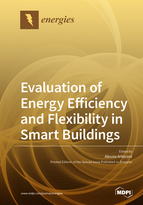Evaluation of Energy Efficiency and Flexibility in Smart Buildings
A special issue of Energies (ISSN 1996-1073). This special issue belongs to the section "G: Energy and Buildings".
Deadline for manuscript submissions: closed (30 April 2020) | Viewed by 65949
Special Issue Editor
2. Department of Mechanical Engineering, KU Leuven, B-3000 Leuven, Belgium
Interests: demand side management; heat pumps; energy efficiency; renewable energy; energy transition
Special Issues, Collections and Topics in MDPI journals
Special Issue Information
Dear Colleagues,
On behalf of Energies, I would like to invite you to contribute to this Special Issue “Evaluation of Energy Efficiency and Flexibility in Smart Buildings”. Buildings’ energy demand and huge energy flexibility potential make them a strategic instrument to improve the efficiency of the overall energy system. This potential impact of the built environment is not yet fully developed and exploited and we, as researchers, can contribute to increasing the general awareness on achievable benefits. In particular, energy efficiency and energy flexibility potential need to be quantified and possible means to unlock such potential need to be disclosed. Particularly relevant is research activity on devices and control strategies that make a building “behave in a smart manner”.
This Special Issue will include articles on, but not limited to, the following areas: energy efficient solutions, new refurbishment technologies, demand side management strategies, renewable energies integration, energy storage, and optimal control.
I look forward to receiving your contribution.
Prof. Alessia Arteconi
Guest Editor
Manuscript Submission Information
Manuscripts should be submitted online at www.mdpi.com by registering and logging in to this website. Once you are registered, click here to go to the submission form. Manuscripts can be submitted until the deadline. All submissions that pass pre-check are peer-reviewed. Accepted papers will be published continuously in the journal (as soon as accepted) and will be listed together on the special issue website. Research articles, review articles as well as short communications are invited. For planned papers, a title and short abstract (about 100 words) can be sent to the Editorial Office for announcement on this website.
Submitted manuscripts should not have been published previously, nor be under consideration for publication elsewhere (except conference proceedings papers). All manuscripts are thoroughly refereed through a single-blind peer-review process. A guide for authors and other relevant information for submission of manuscripts is available on the Instructions for Authors page. Energies is an international peer-reviewed open access semimonthly journal published by MDPI.
Please visit the Instructions for Authors page before submitting a manuscript. The Article Processing Charge (APC) for publication in this open access journal is 2600 CHF (Swiss Francs). Submitted papers should be well formatted and use good English. Authors may use MDPI's English editing service prior to publication or during author revisions.
Keywords
- energy efficiency
- energy flexibility
- optimal control
- demand side management
- smart buildings






